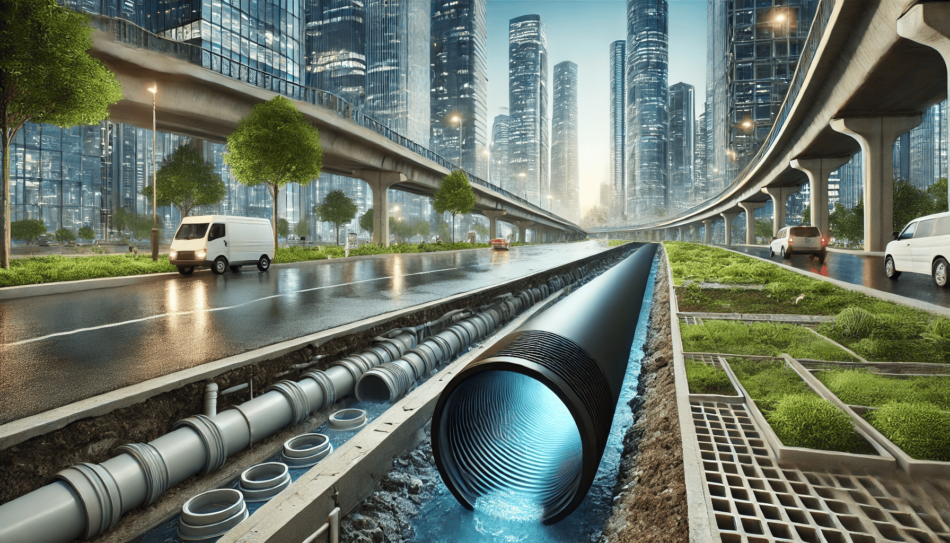Introduction
Urban areas worldwide are increasingly facing waterlogging issues due to rapid urbanization, climate change, and outdated drainage infrastructure. According to the World Bank, urban flooding causes economic losses of over $120 billion annually worldwide. This highlights the urgent need for effective water management solutions.
One of the key advancements in drainage infrastructure is High-Density Polyethylene (HDPE) pipes. These innovative pipes offer durability, flexibility, and environmental benefits, making them an ideal solution for mitigating urban waterlogging challenges.
This article explores the causes and effects of urban waterlogging, the limitations of traditional drainage systems, and how HDPE pipes in Pakistan are revolutionizing urban drainage.
Understanding Urban Waterlogging
A. Causes of Urban Waterlogging
- Impervious Surfaces
- Urbanization replaces natural soil with concrete and asphalt, reducing water infiltration.
- Water accumulates on roads and sidewalks, leading to flooding.
- Inadequate Drainage Systems
- Many cities rely on old drainage infrastructure that cannot handle increased rainfall.
- Poor maintenance of drainage systems results in blockages and reduced efficiency.
- Climate Change and Intense Rainfall
- Unpredictable weather patterns cause more frequent and severe storms.
- Increased rainfall overwhelms drainage systems, leading to urban flooding.
B. Impacts of Waterlogging
- Damage to Infrastructure and Property
- Roads, buildings, and bridges deteriorate due to prolonged exposure to stagnant water.
- Flooded streets increase vehicle damage and traffic congestion.
- Health Risks
- Stagnant water promotes the breeding of mosquitoes, leading to diseases such as dengue and malaria.
- Contaminated water sources contribute to waterborne diseases like cholera and typhoid.
- Economic Losses
- Business disruptions and loss of productivity due to waterlogged streets.
- Increased municipal expenses for drainage system repairs and flood management.
Traditional Drainage Systems: Limitations and Challenges
A. Common Materials Used in Conventional Drainage
- Concrete Pipes – Heavy, prone to cracking, and difficult to install.
- Metal Pipes – Susceptible to corrosion and expensive to maintain.
- PVC Pipes – Brittle under extreme temperatures and not suitable for long-term use in large drainage systems.
B. Challenges of Traditional Drainage Systems
- High maintenance costs.
- Prone to leakages, cracks, and blockages.
- Difficult to install in areas with uneven surfaces or large distances.
Introduction to HDPE Pipes
A. What are HDPE Pipes?
HDPE (High-Density Polyethylene) pipes are made from thermoplastic polymer, known for its high strength-to-density ratio and resistance to corrosion and chemicals.
B. Key Properties of HDPE Pipes
- Flexibility – Allows installation over large distances with fewer joints.
- Durability – Resistant to wear and tear, lasting over 50 years.
- Corrosion and Chemical Resistance – Ideal for transporting various liquids without degradation.
- Smooth Internal Surface – Reduces friction and ensures efficient water flow.
Advantages of HDPE Pipes in Urban Drainage
A. Durability and Longevity
- Understand extreme temperature fluctuations.
- Resistant to UV radiation, preventing material degradation.
- Lasts 50+ years with minimal maintenance.
B. Efficient Water Flow
- A smooth interior prevents sediment buildup and blockages.
- Higher flow rates compared to traditional materials.
C. Ease of Installation
- Lightweight pipes reduce transportation and labor costs.
- Available in long coils, minimizing joints and reducing leakage risks.
D. Environmental Benefits
- Recyclable material, reducing environmental impact.
- Lower carbon footprint compared to concrete and metal pipes.
Case Studies: HDPE Pipes Mitigating Urban Waterlogging
A. Sponge City Initiative (Wuhan, China)
- Integrated HDPE pipes into drainage networks, reducing urban flooding by 30%.
- Combined with green infrastructure, improved water absorption and management.
B. Urban Drainage in European Cities
- Replacing outdated drainage pipes with HDPE reduced maintenance costs by 40%.
- Enhanced flood resilience in cities like London and Amsterdam.
Complementary Innovations in Urban Drainage
A. Sustainable Urban Drainage Systems (SUDS)
- Permeable pavements allow water to drain naturally.
- Green roofs and rain gardens reduce surface runoff.
B. Smart Drainage Systems
- Sensors detect blockages and water flow rates.
- AI-driven monitoring systems optimize drainage performance.
Challenges and Considerations in Implementing HDPE Pipes
A. Initial Costs and Budget Constraints
- Higher upfront investment compared to traditional pipes.
- Long-term savings outweigh initial costs.
B. Technical Expertise and Training
- Proper installation techniques are required for optimal performance.
- Need for skilled labor and specialized training.
C. Regulatory and Standardization Issues
- Ensuring compliance with local building codes and environmental standards.
Future Trends in Drainage Pipe Innovations
A. Advanced HDPE Variants
- Enhanced structural integrity and UV resistance.
- Hybrid materials combining polyethylene with reinforcement layers.
B. Integration with Green Infrastructure
- Using HDPE pipes alongside natural water management systems.
- Reducing urban heat island effects by combining drainage with vegetation.
C. Circular Economy and Sustainability
- Emphasis on recyclability and reusability of HDPE materials.
- Cities adopting closed-loop systems for drainage infrastructure.
Conclusion
Urban waterlogging is a growing challenge, but modern drainage innovations like HDPE pipes offer effective solutions. Their durability, flexibility, and eco-friendly properties make them a superior alternative to traditional materials.
Governments, urban planners, and construction professionals should prioritize HDPE pipes in future infrastructure projects to build resilient cities. Investing in advanced drainage systems today ensures sustainable water management for future generations.
Key Takeaways
- HDPE pipes outperform traditional materials in drainage efficiency.
- Smart drainage systems and green infrastructure enhance flood resilience.
- Future innovations focus on sustainability and circular economy practices.
By adopting HDPE pipes and fittings, urban areas can significantly reduce waterlogging issues, lower maintenance costs, and improve public health.
Explore more content to fuel your curiosity and growth.







